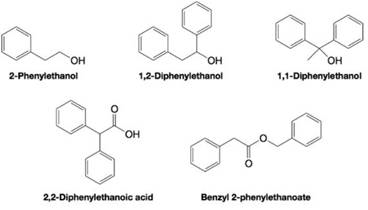
Organic Chemistry
11th Edition
ISBN: 9781118133576
Author: T. W. Graham Solomons, Craig Fryhle
Publisher: Wiley, John & Sons, Incorporated
expand_more
expand_more
format_list_bulleted
Concept explainers
Textbook Question
Chapter 12, Problem 39P
Explain how

Expert Solution & Answer
Want to see the full answer?
Check out a sample textbook solution
Students have asked these similar questions
Draw the structure of the product of the reaction given the IR and MS data.
Spectral analysis of the product reveals:
MS: M 150, M-15, M-43
CH.COCI
AICI,
IR: 3150-3000 cm, 2950-2850 cm
and 1700 cm
Part II. Identify whether the two protons in blue are homotopic, enantiopic, diasteriotopic, or heterotopic.
a)
HO
b)
Bri
H
HH
c)
d)
H
H H Br
0
None
Chapter 12 Solutions
Organic Chemistry
Ch. 12 - Prob. 3PPCh. 12 - PRACTICE PROBLEM Assign oxidation states to each...Ch. 12 - Prob. 2PPCh. 12 - PRACTICE PROBLEM
12.4 What oxidation product would...Ch. 12 - Prob. 5PPCh. 12 - PRACTICE PROBLEM 12.4 Predict the products of the...Ch. 12 - Prob. 7PPCh. 12 - Prob. 8PPCh. 12 - Practice Problem 12.7
Provide retrosynthetic...Ch. 12 - Prob. 10PP
Ch. 12 - What products would you expect from the reaction...Ch. 12 - What products would you expect from the reaction...Ch. 12 - What product (or products) would be formed from...Ch. 12 - Prob. 14PCh. 12 - 12.13 Write reaction conditions and the product...Ch. 12 - Prob. 16PCh. 12 - Predict the organic product from each of the...Ch. 12 - Predict the organic product from each of the...Ch. 12 - Predict the organic product from each of the...Ch. 12 - Predict the major organic product from each of the...Ch. 12 - 12.21 Predict the major organic product from each...Ch. 12 - 12.22 Predict the product of the following...Ch. 12 - Synthesize each of the following compounds from...Ch. 12 - Prob. 24PCh. 12 - 21. Write a mechanism for the following reaction....Ch. 12 - Prob. 26PCh. 12 - Prob. 27PCh. 12 - 23. What organic products A-H would you expect...Ch. 12 - Prob. 29PCh. 12 - Show how 1-pentanol could be transformed into each...Ch. 12 - Provide the reagents needed to accomplish...Ch. 12 - Prob. 32PCh. 12 - For each of the following alcohols, write a...Ch. 12 - Prob. 34PCh. 12 - Prob. 35PCh. 12 - Prob. 36PCh. 12 - Prob. 37PCh. 12 - 34. Synthesize the following compound using...Ch. 12 - 37. Explain how and IR spectroscopy could be used...Ch. 12 - 12.40
When sucrose (common table sugar) is treated...Ch. 12 - 38. An unknown X shows a broad absorption band in...Ch. 12 - Prob. 1LGPCh. 12 - Which of the following could be employed to...Ch. 12 - Prob. 2QCh. 12 - 12.3 Supply the missing reagents.
Ch. 12 - 12.4 Supply the missing reagents and...Ch. 12 - Supply the missing starting compound.
Additional Science Textbook Solutions
Find more solutions based on key concepts
21. Two -diameter aluminum electrodes are spaced apart.
The electrodes are connected to a battery.
...
Physics for Scientists and Engineers: A Strategic Approach, Vol. 1 (Chs 1-21) (4th Edition)
What is the difference between transcription and translation?
Principles of Anatomy and Physiology
1.6 Read the labels on products used to wash your dishes. What are the names of some chemicals contained in tho...
Chemistry: An Introduction to General, Organic, and Biological Chemistry (13th Edition)
33. Write an equilibrium expression for each chemical equation for each chemical equation involving one or more...
Chemistry: Structure and Properties (2nd Edition)
WHAT IF? Rabies, a viral disease in mammals, is not currently found in the British Isles. If you were in charg...
Campbell Biology (11th Edition)
Identify each of the following reproductive barriers as prezygotic or postzygotic. a. One lilac species lives o...
Campbell Essential Biology with Physiology (5th Edition)
Knowledge Booster
Learn more about
Need a deep-dive on the concept behind this application? Look no further. Learn more about this topic, chemistry and related others by exploring similar questions and additional content below.Similar questions
- Choose the option that is decreasing from biggest to smallest. Group of answer choices: 100 m, 10000 mm, 100 cm, 100000 um, 10000000 nm 10000000 nm, 100000 um, 100 cm, 10000 mm, 100 m 10000000 nm, 100000 um, 10000 mm, 100 cm, 100 m 100 m, 100 cm, 10000 mm, 100000 um, 10000000 nmarrow_forwardQ1. (a) Draw equations for homolytic and heterolytic cleavages of the N-H bond in NH3. Use curved arrows to show the electron movement. (b) Draw equations for homolytic and heterolytic cleavages of the N-H bond in NH4*. Use curved arrows to show the electron movement.arrow_forwardWhich is NOT the typical size of a bacteria? 1000 nm 0.001 mm 0.01 mm 1 umarrow_forward
arrow_back_ios
SEE MORE QUESTIONS
arrow_forward_ios
Recommended textbooks for you

 EBK A SMALL SCALE APPROACH TO ORGANIC LChemistryISBN:9781305446021Author:LampmanPublisher:CENGAGE LEARNING - CONSIGNMENT
EBK A SMALL SCALE APPROACH TO ORGANIC LChemistryISBN:9781305446021Author:LampmanPublisher:CENGAGE LEARNING - CONSIGNMENT Organic ChemistryChemistryISBN:9781305580350Author:William H. Brown, Brent L. Iverson, Eric Anslyn, Christopher S. FootePublisher:Cengage Learning
Organic ChemistryChemistryISBN:9781305580350Author:William H. Brown, Brent L. Iverson, Eric Anslyn, Christopher S. FootePublisher:Cengage Learning


EBK A SMALL SCALE APPROACH TO ORGANIC L
Chemistry
ISBN:9781305446021
Author:Lampman
Publisher:CENGAGE LEARNING - CONSIGNMENT

Organic Chemistry
Chemistry
ISBN:9781305580350
Author:William H. Brown, Brent L. Iverson, Eric Anslyn, Christopher S. Foote
Publisher:Cengage Learning
IR Spectroscopy; Author: Professor Dave Explains;https://www.youtube.com/watch?v=_TmevMf-Zgs;License: Standard YouTube License, CC-BY